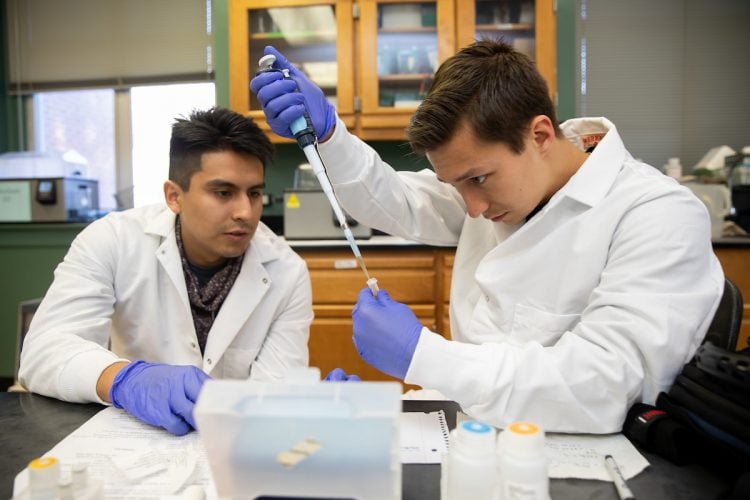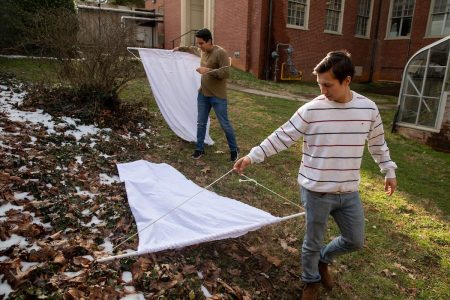Tick talk: Biology students research the spread of cat scratch fever through ticks

Eynnar Claros Chacon (left) and Allen Vaytser extract DNA samples from ticks in the lab
On a warm afternoon this spring, Eynnar Claros Chacon ’19 and Allen Vaytser ’20 ventured into the woods behind Randolph’s softball field. The two biology majors carefully combed the forest floor with “draggers”—long, white sheets coated with carbon dioxide—hoping their prey would take the bait. Sure enough, when they returned to Martin Science Building, the draggers were speckled with a variety of tiny, blood-sucking arachnids.
Chacon and Vaytser’s independent research project was designed to determine how many of the ticks carried the bacterial pathogen, Bartonella henselae, which causes the disease known as “cat scratch fever.” The primary symptom of the infection is swollen, tender lymph nodes near the site of a cat scratch, but previous studies have shown that ticks can carry and transmit the disease to humans as well.

Eynnar Claros Chacon and Allen Vaytser use their “draggers” to catch ticks on campus
Biology professor Adam Houlihan is overseeing the project. He had the idea to research the topic after taking his daughter to the doctor for a tick bite and similar symptoms last fall. She was tested for Lyme disease, but Houlihan wondered if she should have been tested for Bartonella as well.
“Bartonella is one of the things they don’t really test for in doctor’s offices,” Houlihan said. “We don’t know how common this particular infection is and how easy it is to be transmitted from tick bites. So, the first step is really seeing how prevalent it is in ticks.”
After catching the ticks, Chacon and Vaytser plucked their specimens from the cloth and dropped them in ethanol. The substance killed the ticks, and the students extracted their DNA proteins to run through a Polymerase Chain Reaction (PCR) machine, which produced copies of specific DNA segments. Then, they used a process called gel electrophoresis to examine the DNA fragments and compare them to the Bartonella gene. The students used a Randolph Innovative Student Experience (RISE) grant to purchase the PCR machine and a laptop to record data.
They did not find conclusive evidence of Bartonella in the deer ticks and lone star ticks they collected this spring, but the students are not done with the project. Chacon plans to continue his part of the research in graduate school, and Vaytser resumed work at Randolph this fall. Both plan to enter the medical profession, and they were eager to contribute to the field.
“I like studying genetics and DNA and how it all works,” Chacon said. “I wanted to do this research because if I’m going to medical school, lab work is sort of a requirement. But I think the main reason we were both interested in this project is that the experience not only benefited us, but we also had an opportunity to help people.”
“I wasn’t a big fan of research in the lab at first,” Vaytser added. “I’m more interested in seeing patients and working with people, but doing this work sort of opened my eyes and showed me that the research side can be pretty fun too. Plus, it’s exciting to be researching something that hasn’t really been done before.”
Tags: Adam Houlihan, biology, research, RISE grant, Vita No. 7
